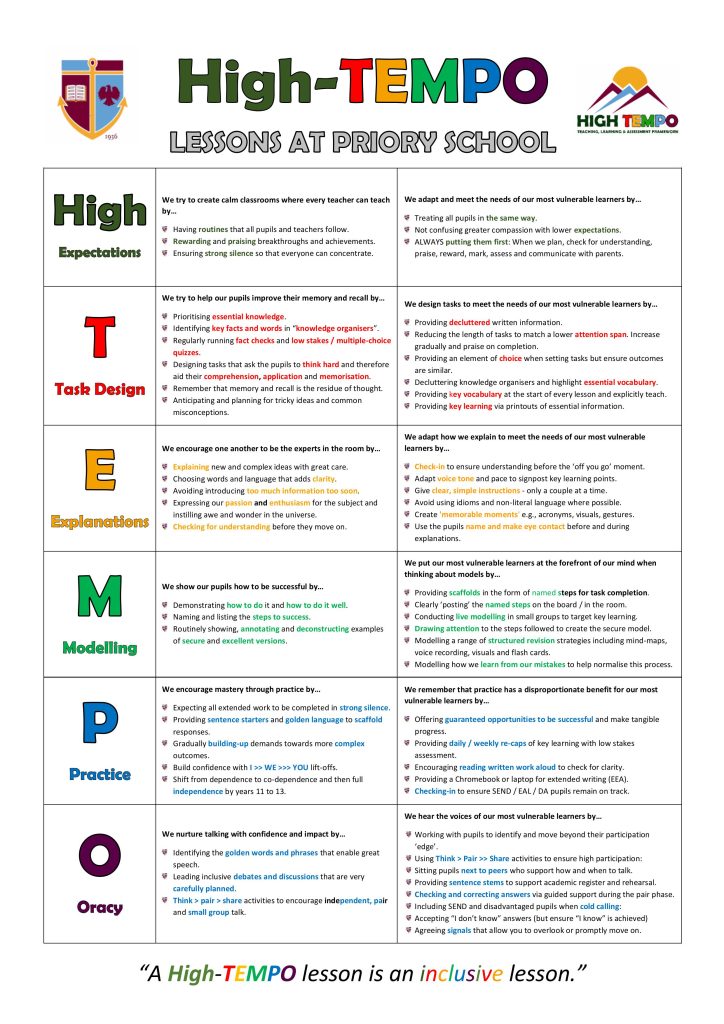The business of teaching, learning, and assessment is fascinating for some and maybe less so for others. However, since you have landed on this part of our website, I feel confident you are either equally interested or simply curious about the core business of learning at Priory School.
Pedagogy is not left to chance here, as it is in many other schools. Too often, a single unit of work or lesson is provided for every child to consume, even though a class of just six, twelve, or eighteen has many different starting points. At Priory School, we are committed to adapting our teaching and learning to meet the needs of each child, rather than the “old way” of differentiating. This traditional method can separate and pigeonhole young learners, creating ‘glass ceilings’ that ignore the reality that every child develops at a different pace. We believe every lesson must be adapted for each child, every day.
Meanwhile, assessment is not simply about tests and examinations, though they do play a part. Assessment can be a sober evaluation of teaching and learning, or it can be an insightful and even fun activity that promotes greater learning. This is why assessment at Priory School is viewed as assessment of learning, for learning, and as learning. Feedback, delivered with kindness and rooted in very high expectations, fuels a child’s ambition, learning and aids more rapid progress.
The Seven Core Principles of Great, Teaching, Learning and Assessment
As our pupils get older and are exposed to higher levels of academic rigor in their middle and later years of Prep School, their formal lessons are united by a set of core principles that inform not only how we teach, but also how they learn.
- Classrooms must be attentive: If a pupil is bored, disengaged, or making little progress, we need to change our curriculum and lesson plans.
- Teachers must provide great explanations: Teachers are the experts in the room. When imparting wisdom, they must know what to say and how to say it. We must use stories, anecdotes, metaphors, data, visuals, models, and artifacts to bring our knowledge to life with great enthusiasm.
- Tasks and activities must be ‘high value’: When we reach the ‘off you go’ moment with a class, all pupils must be clear on what to do and how to do it well. The litmus test of any activity is the degree to which pupils are absorbed and engaged throughout.
- Reading must be promoted by all: Reading is everyone’s responsibility. It is used as an integral feature of every lesson to impart new knowledge and understanding, or at the start of lessons or for homework to enrich and extend their knowledge and awareness.
- Writing must be promoted by all: Through comparative, annotated, and deconstructed models, pupils can recognise both ‘secure’ and ‘excellent’ writing. With scaffolds, pupils of all abilities learn to write with confidence.
- Homework must be meaningful and widely valued: Pupils’ attitudes toward homework will depend on the degree to which they recognise the value of what they are being asked to do in their own time.
- Classroom behaviours must be well managed: All classrooms benefit from a combination of explicit, school-wide routines and norms, alongside the unwritten and implied expectations of every individual teacher. Every teacher embraces the philosophy that a lesson must be worth behaving for in the first place.
High-TEMPO Teaching, Learning and Assessment
Teachers of our older pupils are united by a shared language and framework that defines and articulates what constitutes great lessons and great learning.
While every teacher is encouraged to inject their own creativity and wisdom into the design and delivery of each lesson, they are also aligned with the best practices that exist in UK and global schools today.
A simple summary of what high-TEMPO looks like from the perspective of a pupil or a parent appears below.


